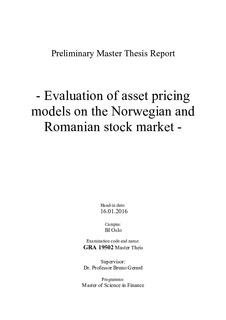| dc.description.abstract | This master thesis evaluates the stock characteristics of two main asset-pricing
models in both the Norwegian and Romanian stock markets with the addition of
liquidity, momentum, beta and idiosyncratic volatility in order to:
- identify what factors best desribe the markets;
- suggest the relevant models best suited for the markets in question
(developed vs developing);
- infer the possible roots of the differences (if any) between a developed stock
market and a developing one on the basis of the analysis aforementioned.
This thesis is inspired by the paper “Evaluating asset pricing models in the Korean
stock market” written by Soon-Ho Kim, Dongcheol Kim, Hyun-Soo Shin and
published in the Pacific-Basin Finance Journal and the paper “The Cross-section of
Expected Stock Returns” written by Jonathan Lewellen and published in the Critical
Finance Review Journal. The stock characteristics used for evaluating the stock
markets come from the asset models Fama and French APT five-factor model
(2014) and Hou, Xue and Zhang four-factor model (2012). In addition to the stock
characteristics that compose the aforementioned models, four stock characteristics
are added to the models: liquidity, momentum, beta and idiosyncratic volatility.
These models will be evaluated through Fama-Macbeth cross-sectional regressions
and the results will be compared by means of t-stats, p-values and R2 measures. The
stock return data are obtained from DataStream. Romania has monthly data from
January 2007 to December 2016 while Norway has monthly data from December
2005 to December 2016. The Romanian sample contains 102 companies whilst the
Norwegian sample contains 147 companies.
The results show that book-to-market equity ratio and ROE are important
characteristics for the Romanian market. Norway on the other hand follows more
or less the path of a mature market, whereby the majority of the traditional
characteristics have explanatory power. Investments variable can be omitted in the
analysis of both markets without much loss of information. In terms of the
suitability of the models, models that incorporate book-to-market equity ratio and ROE characteristics perform best in the Romanian case whilst the existing assetpricing
models can be used together for a better description of the Norwegian
market. In terms of the differences between a developed and a developing market,
the results of this thesis do not provide enough evidence for such an inference.
Moreover, the results in this thesis should not be generalized especially across
developing markets, due to the small stock sample size and the limited time horizon. | nb_NO |

